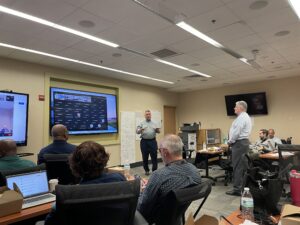On March 7, 2024, the Maryland Region V Healthcare Coalition participated in a Chemical Emergency Surge Tabletop Exercise (TTX) hosted by the Maryland Hospital Association (MHA) that examined the preparedness efforts taken and response actions initiated to a mass casualty incident related to widespread sarin exposure. The exercise was designed to review existing emergency care assets, evaluate roles, and identify operational gaps during a large-scale chemical incident. The Maryland-National Capital Region Emergency Response System (MDERS) observed the exercise to gain better insights into healthcare response.
The Chemical Emergency Surge TTX covered three modules that engaged essential response components within the scenario, including initial recognition, community collaboration, and ongoing healthcare coordination. Each module contained information portraying a sarin attack at a large community gathering and the aftermath of chemical exposure casualties. The scenario emphasized the need to assess patients, decontaminate, treat injuries, and coordinate with public health and emergency managers. Throughout the exercise, participants from fire/EMS, public health, emergency management, acute-care facilities, and the Maryland Healthcare Coalition provided suggestions on specific response procedures utilized to reduce chemical exposure.
In the first module, units responded to a potential chemical agent release in a densely populated area with office buildings, retail space, and schools. Within minutes, multiple patients experiencing various symptoms arrived at nearby hospitals.  During the response phase, participants discussed a variety of initial actions that involved the activation of the Emergency Operations Center (EOC), preparing Hazardous Materials (HAZMAT) operations, contacting poison control personnel, and deploying decontamination equipment to establish the immediate removal of contaminants. Considering the large acute exposure, participants reviewed real-time information sharing capabilities between hospitals and response partners particularly due to requesting specialized EMS transportation resources and disseminating critical incident information. In preparation for treating an influx of patients, these response activities set the foundation for ongoing healthcare coordination.
During the response phase, participants discussed a variety of initial actions that involved the activation of the Emergency Operations Center (EOC), preparing Hazardous Materials (HAZMAT) operations, contacting poison control personnel, and deploying decontamination equipment to establish the immediate removal of contaminants. Considering the large acute exposure, participants reviewed real-time information sharing capabilities between hospitals and response partners particularly due to requesting specialized EMS transportation resources and disseminating critical incident information. In preparation for treating an influx of patients, these response activities set the foundation for ongoing healthcare coordination.
In the next phase, participants were informed of the evolving nature of the emergency with hospitals, clinics, physician offices, and other healthcare facilities becoming inundated with victims suffering from a range of adverse effects due to the sarin exposure. Participants referred and adhered to hospital protocols related to chemical emergency response to determine alternate areas for triage, on-site decontamination, and community evacuation. With the potential for misinformation and public concern, participants activated the EOC Joint Information Center (JIC) to coordinate public information with Healthcare Coalition members to provide consistent communication to mitigate mass panic.
While the actions of participating response agencies diminished the harm from chemical attack in the primary and immediate vicinity, participants explored other alternative methods to maintain and uphold regional healthcare coordination. Participants assessed mutual aid agreements to transport patients for ongoing care to facilities with appropriate resources, collect/dispose of contaminated materials, request staffing support, and execute situational awareness communication strategies among healthcare partners.
As the exercise concluded, participants enhanced their knowledge about the emergency notification processes and existing mutual aid agreements that were crucial in responding to and coordinating medical care. The discussion-based exercise examined the response capabilities across hospitals and healthcare facilities, revealing the necessity for more robust collaboration, resource allocation, and communication practices. MDERS supports active participation in exercises, viewing them as an indispensable training tool that fosters personnel development and optimizes operational efficiency.


